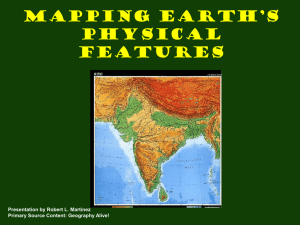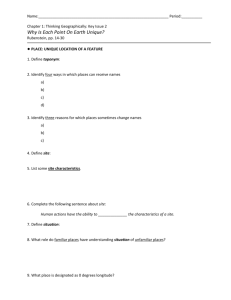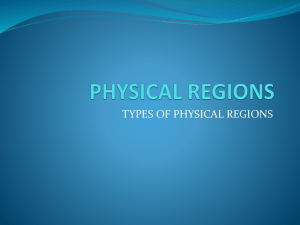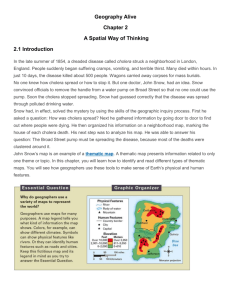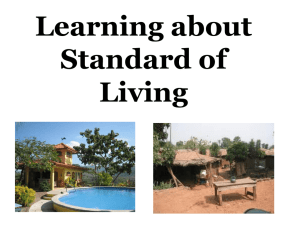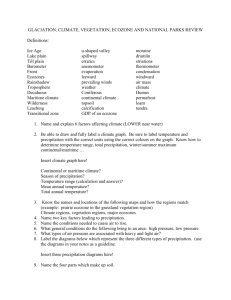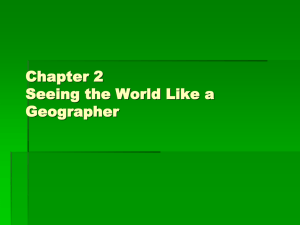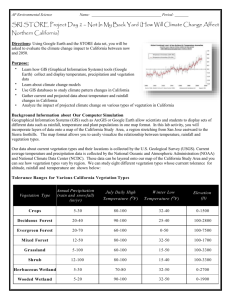Student Text - Thematic Maps
advertisement
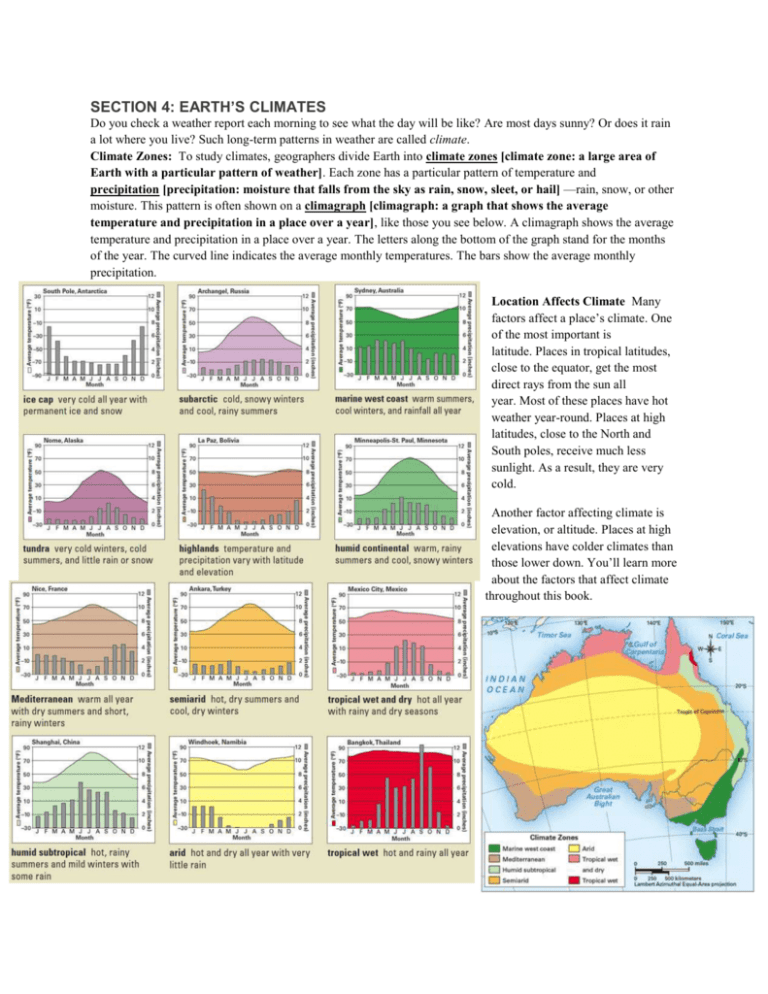
SECTION 4: EARTH’S CLIMATES Do you check a weather report each morning to see what the day will be like? Are most days sunny? Or does it rain a lot where you live? Such long-term patterns in weather are called climate. Climate Zones: To study climates, geographers divide Earth into climate zones [climate zone: a large area of Earth with a particular pattern of weather]. Each zone has a particular pattern of temperature and precipitation [precipitation: moisture that falls from the sky as rain, snow, sleet, or hail] —rain, snow, or other moisture. This pattern is often shown on a climagraph [climagraph: a graph that shows the average temperature and precipitation in a place over a year], like those you see below. A climagraph shows the average temperature and precipitation in a place over a year. The letters along the bottom of the graph stand for the months of the year. The curved line indicates the average monthly temperatures. The bars show the average monthly precipitation. Location Affects Climate Many factors affect a place’s climate. One of the most important is latitude. Places in tropical latitudes, close to the equator, get the most direct rays from the sun all year. Most of these places have hot weather year-round. Places at high latitudes, close to the North and South poles, receive much less sunlight. As a result, they are very cold. Another factor affecting climate is elevation, or altitude. Places at high elevations have colder climates than those lower down. You’ll learn more about the factors that affect climate throughout this book. SECTION 5: EARTH’S VEGETATION Think about the climate where you live. Now think about the kinds of plants that grow nearby. In an arid [arid: dry or lacking rainfall; also a climate or climate zone that is hot and dry all year with very little rain] climate, like a desert [desert: a geographic region with too little rainfall to support much plant life; also a vegetation zone] , you might see hardy cacti. In a humid continental [humid continental: a climate or climate zone with warm, rainy summers and cool, snowy winters] climate, you might see lofty trees that stay green all year. Climate has a major effect on the kind of vegetation that grows in a place. Vegetation Is Adapted to Its Environment: Plants of some kind grow nearly everywhere on Earth. But in order to survive, plants must adapt to their environment. Plants can adapt to even extreme environments. A tundra climate zone is very cold and dry. Yet small plants and bushes grow there. In arid climates, cacti can go for long periods without water. Other kinds of vegetation need lots of rainfall to survive. Other factors besides climate affect what plants grow where. Among them are elevation, amount of sunlight, and richness of the soil. Global Vegetation Zones: Geographers study where different plants grow by dividing the world into vegetation zones [vegetation zone: a large area of Earth with a certain mix of plants and trees that are adapted to similar conditions] . In each zone, a certain mix of plants has adapted to similar conditions. Like climate zones, vegetation zones are affected by their location on Earth. They range from the barren ice cap zones at the poles to the dense broadleaf evergreen forest zones near the equator. SECTION 6: POPULATION DENSITY In 2007, about 8 million people lived in New York City. They were jammed into an area of about 300 square miles. Compare this with the town of Skwentna, Alaska, where approximately 150 people were spread out over about 450 square miles. When it comes to crowding, these two places are about as different as they can be. Geographers show these kinds of differences using population density maps. Population Density Measures: Crowding Population density tells us how crowded a place is. To calculate the density of a place, divide the number of people there by its land area. The higher the result, the more crowded the place is. In 2007, New York City had a population density of about 26,000 people per square mile. In contrast, Skwentna had less than 1 person per square mile. Population density affects how people live. In Skwentna, houses are spread out. There are no roads. People use airplanes, boats, or snowmobiles to get to the local store and the post office. Skwentna’s version of rush hour comes in February, when dogsled racers speed through town. In New York City, people live packed in high-rise apartments. They may have hundreds of neighbors just in their own building. Every day millions of “straphangers” hold on tight as they jostle one another in the city’s crowded subways. SECTION 7: ECONOMIC ACTIVITY Do you like chocolate? This sweet treat comes from cocoa beans, the fruit of the cacao tree. The cacao tree grows only in hot, tropical areas near the equator. But factories that use cocoa beans to make chocolate candy are found in Europe and the United States.The locations of cocoa plantations [plantation: a large farm, especially in a hot area]and candy factories are examples of the kind of information you might see on an economic activity map. Land Use Shows How People Make a Living: Economic activity maps often show patterns of land use [land use: the ways in which people use a particular area of Earth’s surface; for example, for farming, development, or preservation] . Land use is the way people use the land they live on to meet their needs. In some areas, people use land for farming. In others, they may use it for mining. Natural Resources Affect Economic Activities: Economic activity also depends on a country’s natural resources. Forestry [forestry: the planting, growing, and harvesting of trees] , or the harvesting of trees to produce wood products, is important in forested areas. Near oceans, fishing is an important industry. Many resources lie hidden beneath the ground. This is true of both minerals and fossil fuels [fossil fuel: any fuel, such as petroleum, coal, and natural gas, that is made from the remains of prehistoric plants and animals] such as oil, coal, and natural gas. Uranium is another underground energy resource. It provides fuel for nuclear power plants. In contrast, moving water is an easy-to-find energy resource. Dams can be built on rivers to harness the moving water’s energy and convert it to hydroelectric power [hydroelectric power: electricity that is generated from the power of moving water]. SECTION 8: REGIONS As you have learned, geographers use many kinds of maps to make sense of the world. Some of these maps focus on physical geography. Others focus on human geography. All of them reveal interesting patterns to explore. Geographers use these patterns to organize the Earth’s surface into regions. A region is an area with one or more features that set it apart from other areas. As you’ll see, the concept of region allows geographers to divide the world in useful ways. Unique Features Define a Region: Think about the community you live in. Does it have a business district? A shopping mall? An industrial park? A civic center? A residential neighborhood? Each of these areas has features that set it apart from other areas. You might think of one as a business region, another as a shopping region, and still another as a housing region. Each region looks different. Each has a different purpose. Each has different needs. Geographers define regions in several ways. The Sunbelt is a region defined by physical features. It is a region made up of states in the southern part of the United States. What sets the Sunbelt apart from other regions is its warm, sunny climate. The Corn Belt is a region defined by human features. It is made up of states in the center of the country where raising corn is an important economic activity. Dividing the World into Seven Major Regions: The world is a very large place to make sense of. For this reason, geographers usually divide it into regions to study. These world regions are still very large. But each has its own special features. This book divides the world into seven major regions. Each region is shown in a different color on the world regions map below. These colors are your guide to finding each region in this book. Your study of a region will begin with an introduction to its most important physical and human features. In that introduction, you will begin to see what makes each of these regions unique.
